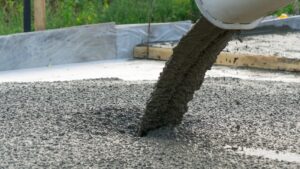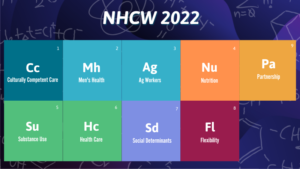“Before a drop of concrete is poured, you need to build a foundation. Without it, the road will lack durability, especially as the surface material begins to show signs of wear, says John Deere, a leading construction manufacturing and agricultural company.

This advice, although literal, can be applied to a variety of situations, including that of Community Health Centers (CHCs). The celebration of their efforts kicks off this week, as National Health Center Week, hosted by the National Association of Community Health Centers (NACHC), runs from August 6-13, 2023.
NACHC has dubbed this year’s theme “The Roadmap to a Stronger America:” an ode to the CHCs stretching for miles that contribute to the success and health of underserved communities across the country.
If you will, walk with us as we imagine a path forward for this year and beyond:
John Deere, who may well know best, says there are three main steps to building a road.¹
-
Excavating
-
Grading
-
Paving
 Excavating
Excavating
The excavation process requires workers to move large obstacles out of the way.¹ When compared to health center patients, this may look like lessening the effects on Social Determinants of Health (SDOH) by conducting routine screenings and providing support when needed.
Focus Days to Address Related to Excavating:
- Public Health in Housing Day
- Healthcare for the Homeless Day
Maslow’s Hierarchy of Needs says that physical safety must first be met before a person can even begin to be concerned with their other needs. National Health Center Week begins by recognizing those struggling with their physical safety. Realistically, patients can’t realize their full health potential- cannot drive forward- until they have safe, secure housing.
Tools that can help with the excavation process:
- Contextual Data; Physical environment accounts for about 10 percent of health outcomes.² This article from HealthcareIT News says that providers can use SDOH data to be proactive and identify high-risk and vulnerable patients, before health issues arise. RPM data can provide the same level of insight. Health systems can integrate SDOH data with RPM data to give the clinicians a full picture of the situation: physically and socially. Cross-sector partners can then coordinate to create targeted care plans for these patients.
- Community Partners: Sometimes the road to health equity seems to be endless. When there’s a roadblock, partners can certainly give us the fuel to keep going. Lending both extra resources and ancillary motivation, partners help us go faster and longer when we all work together.
Grading
This part of the road construction process consists of shaping and leveling the road.¹ During this process, engineers must consider multiple factors, such as soil type, soil quality, and erosion, much like varying SDOH. Agricultural workers, health center patients and other stakeholders continuously shape the state of our healthcare industry today, with the unique combination of their lived experiences, skillsets and societal investments.
Focus Days to Address Related to Grading:
- Agricultural Worker Health Day
- Patient Appreciation Day
- Stakeholder Appreciation Day
Tools to help level the playing field:
- Patient-centered care: Patient perspective is critical when building an equitable healthcare industry. Health equity aims to meet patients where they are, allocating resources where and when it’s needed the most. Patients are at the center of health care, which makes their voice invaluable for the representation of their communities. Patient engagement keeps health centers accountable for providing quality services to the medically underserved. Patients must continue to be encouraged to voice their concerns to ensure optimal care for their unique needs. At its core, patient-centered care should include³:
-
- Collaborative, coordinated and accessible care
- Care focused on physical, as well as emotional wellbeing
- Care that takes into account patient and family preferences, cultural traditions and socioeconomic status
- Consideration of patients and their families as part of the team when making decisions, rather someone who passively takes directions
- Education provided to the patient and their caregivers surrounding medical conditions and processes, which will allow them to make more informed decisions.
- Population Health Planning: Population health practices aggregate SDOH and health data to produce evidence-based clinical guidelines that further assist in the creation of curated care. Population segmentation analysis can help you split your patient population into groups divided among demographics, health status, or general motivation. For example, you can stratify patients by location, gender, disability, occupation, age, or ethnic group. Doing so helps identify different SDOH within your patient population that can help you pinpoint common disparities found in your community. Using this approach allows health systems to assist each segment and create and track success metrics. This data can be used to persuade stakeholders to invest more in CHCs.⁴
Paving:
This final part of the process entails laying multiple base layers, as well as the main surface. Pavements can be rigid with a longer lifespan or flexible, and therefore better able to adapt to changing temperatures. When driving communities toward better health, there are always multiple options a health system can employ. Some solutions are tried and tested; others are innovative and allow room for improvement beyond the current standard. Heath centers have always had to adapt to changing external factors- being health systems always on the frontier of change.
Focus Days to Address Related to Paving:
- Health Center Staff Appreciation Day
- Children’s Health Day
Tools to pave the way toward the future:
- RPM and RTM: Flexible and innovative solutions such as RPM and Remote Therapeutic Monitoring (RTM) can help patients and providers withstand heating pressures, such as financial constraints, staff shortages, or administrative burden.
- Learn more about this topic: https://certintell.com/wp-content/uploads/2022/06/WHITE-PAPER-Solutions-for-Healthcare-Workforce-Shortages-.pdf
- Health center staff and children: These two groups will undoubtedly influence the future of the healthcare industry. Investment from health center staff has direct impact on patients. Certintell believes in your ability to use your voice and your work to do good! Investment in children’s health will also be critical as many changing elements of our society make it more difficult to realize full health potential, whether that be economic disparities or fluctuating environments. NHCW serves as a reminder that we should all invest in these community pillars as much as we can. Thank you health center staff for everything that you do! Certintell commends you this year and many to come!
SOURCES
¹ “All About Road Construction.” John Deere, 2022, www.deere.com/en/roadbuilding/all-about-road-construction.
² “Addressing Social Determinants of Health With Data Interoperability.” Healthcare IT News, 20 Apr. 2020, www.healthcareitnews.com/blog/addressing-social-determinants-health-data-interoperability.
³ “What Is Patient-Centered Care?” NEJM Catalyst, 17 Jan. 2017, catalyst.nejm.org/doi/full/10.1056/CAT.17.0559.
⁴ “Section 2: Engaging Stakeholders in a Care Management Program.” Agency for Healthcare Research and Quality, www.ahrq.gov/patient-safety/settings/long-term-care/resource/hcbs/medicaidmgmt/mm2.html.




